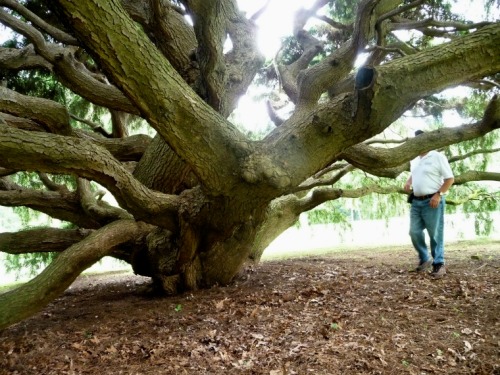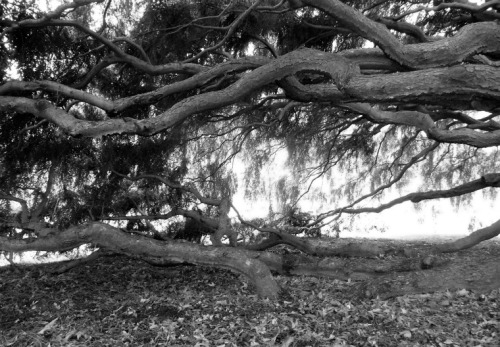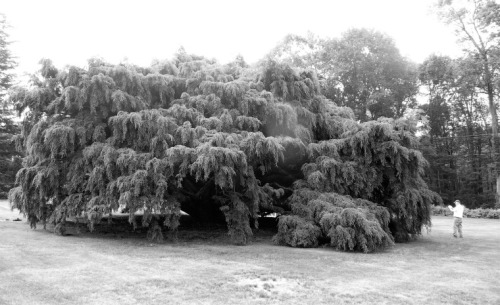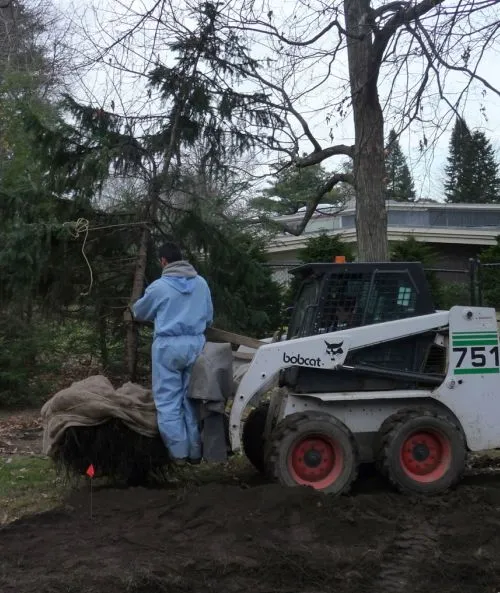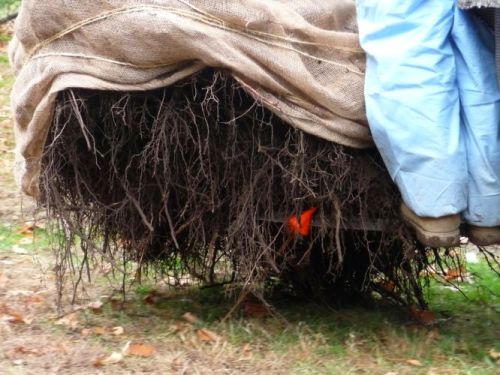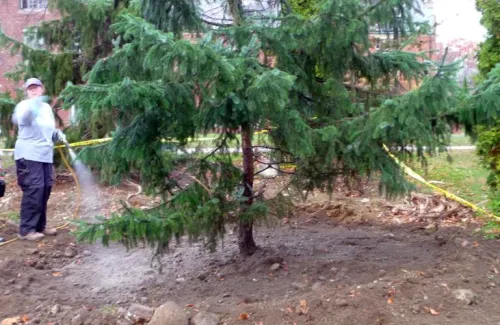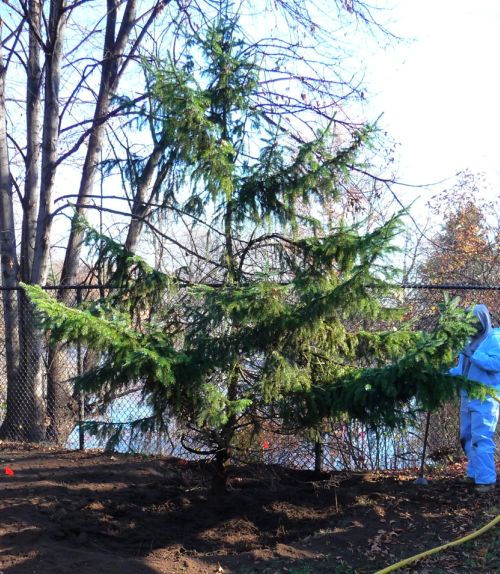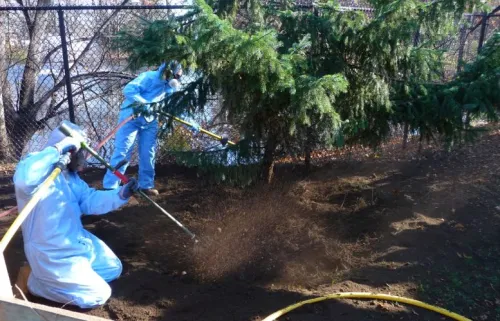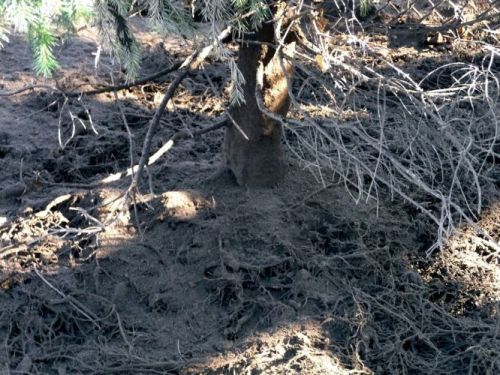Air spade tree transplanting. Warning: Long post, tons of photos.
Probably the biggest draw of the Elm Bank workshop on September 10, 2009, was Mike Furgal’s moving of a 6″ caliper elm hybrid. Mike first developed the method of air-tool bare-root transplanting in 2004, and has been working on it since, moving ornamental specimens and canopy trees with great success. The biggest tree he has moved was a 21″ caliper, 50′ high mulberry (it was the owner’s choice), in November 2008; this past July he worked on Matt Foti’s project of moving several large trees, including the five 40′ high London plane trees showcased in posts on www.takingplace.net.
(To find those posts, click on the link in the last sentence, and then click on the ‘Plants’ link in Categories listed on the right side of the page. All posts related to air-tool transplanting will pop up; the links for the London plane project are dated July 29, July 31, August 3, and August 7. Browse among earlier ‘Plants’ posts for more articles on bare-root transplanting.)
So Mike has lots of experience with this work, and continues to think about the best ways — for the trees and for the crews — to move trees. He made a number of observations in his Elm Bank talk about air-tool transplanting:
1. The larger the tree, the more cost-effective the bare-root move is.
2. Bare-root transplanting lets roots settle immediately into the soil on the new site. With no root ball/surrounding soil interface to impede moisture saturation or interrupt moisture flow, the roots are able to adapt right away and start growing. As a result, watering and aftercare are also easier and more effective.
3. The greater the depth of good quality soil, the more apt roots are to grow down as well as out.
4. Arborists and landscape architects MUST stress the need for sustained aftercare once a tree has been bare-root transplanted. One year of attentive watering is good, but two, three, four, or even five years is better.
5. Mike asked “Do we arborists plant trees or do we install them?” When you install a B&B tree, he suggested, you dig a hole, put the tree in the ground, backfill, and water. When you plant a tree, you remove the wire basket, remove the burlap and twine, possibly break up the soil mass, spread the roots out to promote outward growth, and water sufficiently for the next couple of years for the tree to root into its home. ‘Installing’ a tree makes the tree simply a product, a commodity that can (and may have to be) replaced. ‘Planting’ a tree recognizes and attends to the needs of this living organism, and promotes its good health and sustained long life.
6. Air tools dry out root surfaces — pre-watering of the root mass and soil around a tree to be moved helps the tree hydrate and maintain turgor pressure during the transplant operation. Mike suggested that trees may have a greater tolerance for short-term root drying than is commonly assumed, and urged the audience to observe what happens to the roots of trees they may move bare-root, and how those trees react to the process.
7. When you use an air tool to excavate a tree for transplanting, dig your soil trench in sections, and dig it deep enough (measured in feet, not inches) to hold quite a bit of blown out soil, thus minimizing the number of times it needs to be emptied. Mike pointed out that it’s necessary to consider how best to move the excess soil around; it’s important to plan the job at the outset, including how to access the plant(s) to be moved, how to avoid plants to remain, and where to stockpile the blown-out soil.
8. The bare-root process can allow arborists use lighter equipment (depending on tree size, of course) than may be necessary for B&B trees. A 2000-pound mini-excavator can pick up a six-inch elm, while to move that same tree B&B would require a large backhoe or front-end loader.
9. The more fibrous a tree’s root system, the less likely it is to need cabling after a bare-root transplant. A root mass’s size, the nature of its rooting, and the relationship between those factors and the tree’s size will also factor into the decision to cable a newly-planted bare-root tree.
Mike had blown soil out from around the roots of the Elm Bank elm the day before the workshop, and kept them covered until the workshop demonstrations began.
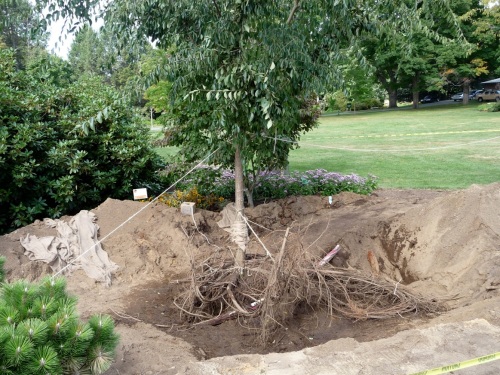
Healthy elm tree, soil blown off its roots, ready to be moved.
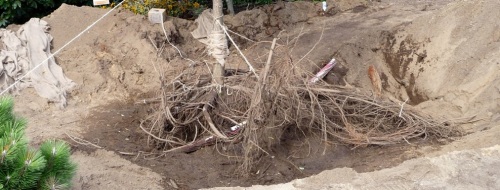
Closeup of the roots. This root mass measured 14 feet across at its widest. Roots have been pigtailed -- that is, tied together and lifted to keep them from breaking during the air-tool excavation and move.
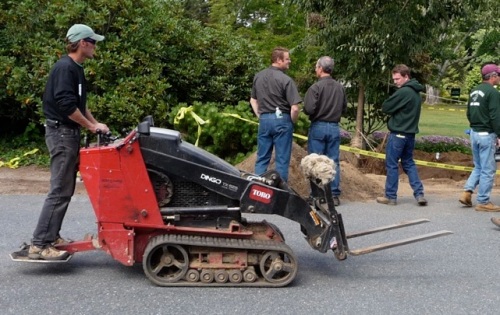
Dingo used to move the tree, whose new location was about fifty feet away from where it originally stood.

Mike Furgal and his assistant planning their course of action. Note the tagline leading out from the canopy; it will be used to stabilize the tree during the move and backfill operation.

Mike directs the Dingo forks under the root plate while his assistant holds the trunk stable. Note the heavy burlap padding both on the Dingo and on the tree trunk.
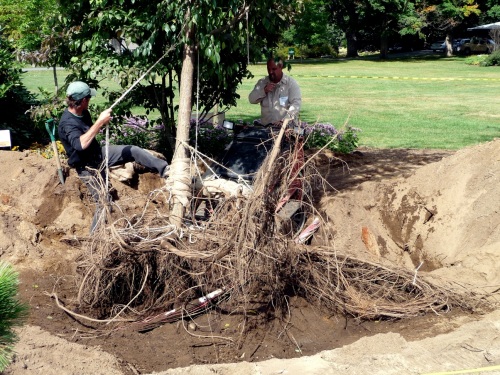
Lifting the tree. Trunk padding rests on Dingo padding; tagline helps the trunk and canopy remain steady.

Beginning to move the tree requires that it sit firmly on the forks, and remain balanced through the move.
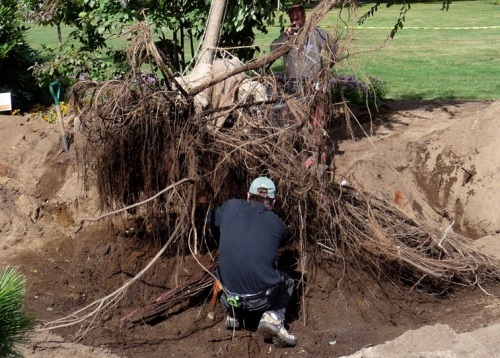
Cutting the last few anchored roots, and any roots broken in the process. Loppers work best; be sure they are sharp enough to make clean cuts (a set of root-pruning tools is useful, as cutting dirty roots with top-growth tools will ruin their blades quickly).

Moving the elm up its soil ramp and out of its plant bed; an attending arborist jumps in to help the roots past this thriving pine.
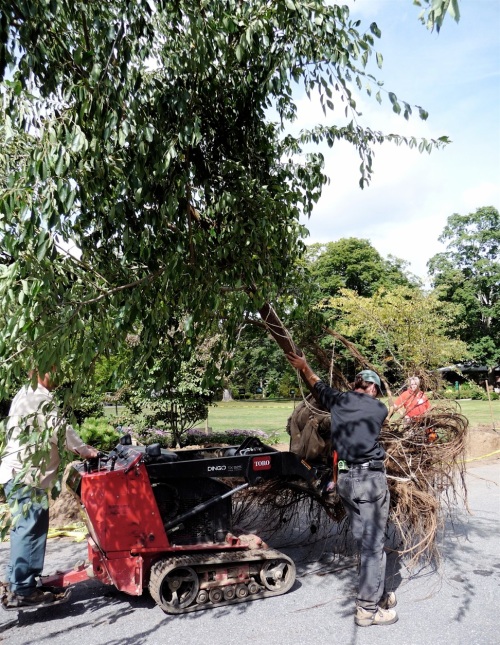
Elm tree on the move. Stabilizing the trunk and moving slowly keeps the job safe.
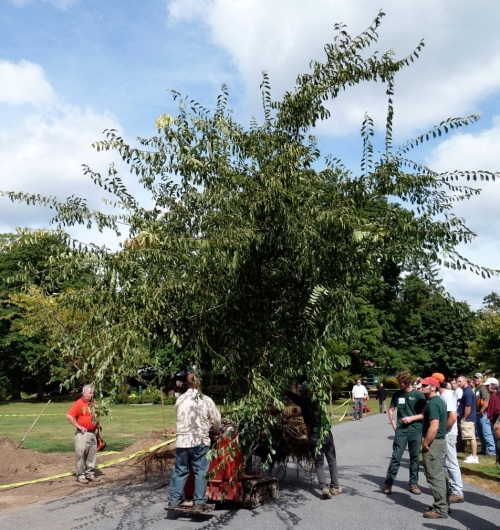
Big canopy. This year's growing season was moist and fairly cool, leading to lots of topgrowth and long twig extension.
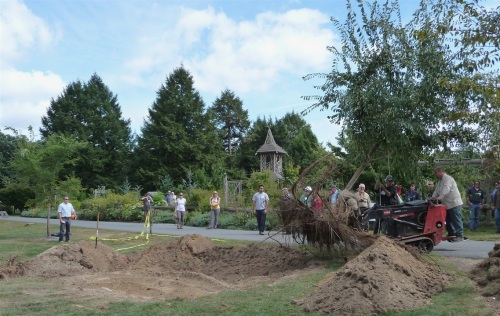
Mike steers the Dingo to the crater he has dug. It is relatively shallow, to match the elm root mass depth, and wide (though not wide enough at first -- a couple of trenches had to be dug beyond the crater at the last minute to some extra-long roots).

Lowering the elm into its crater.
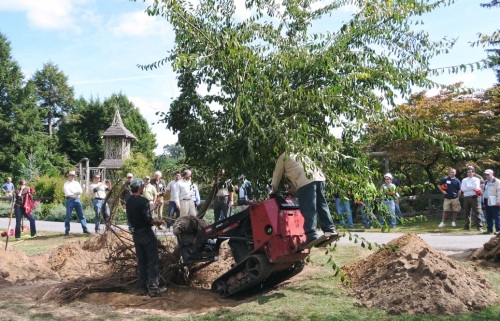
Whoa! A moment of excitement, when tree weight and crater's-edge slope combined to tip the Dingo on its tracks.

The Iwo Jima shot. A team of volunteers ran in to right the tree.
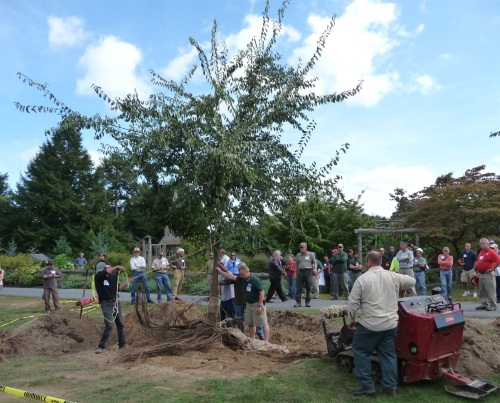
Holding the tree upright once the Dingo forks have been pulled out.

Again, holding the tree upright. The pigtails now get cut open and roots spread out radially from the trunk.
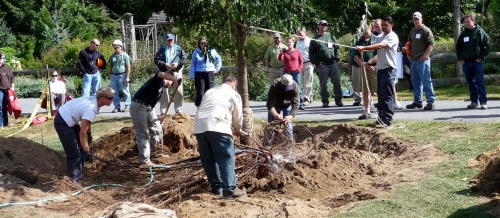
Freeing the roots, beginning to dig in backfill, and watering to make a soil slurry that will eliminate air pockets and help anchor the spread-out root plate.

With the tree in its new location, burlap padding the trunk may be removed.
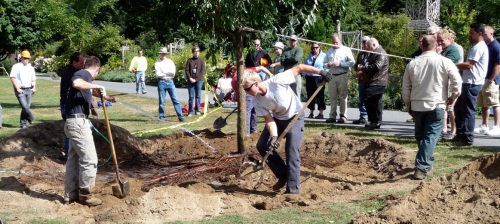
Digging in the root mass. It's important to pack the soil directly under the tree's trunk, to eliminate air holes and ensure against settling of the tree lower in its hole over time.
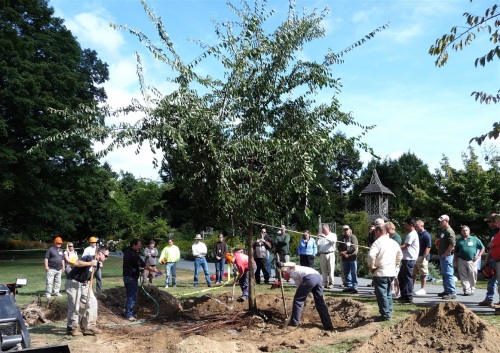
Big canopy on this tree, with a root mass to match.

A bucket on the Dingo shakes backfill -- the native soil onsite in this case -- into the crater as workers wield shovels and a hose.
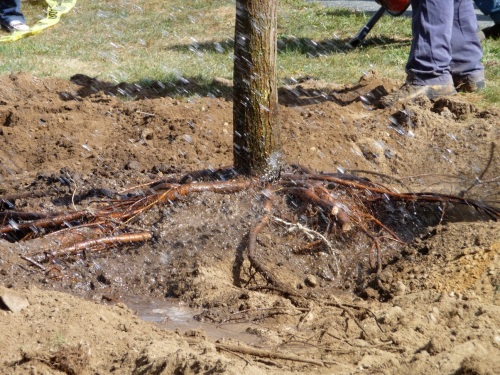
Trunk flare, placed in the proper relationship to finish grade. Note the cut root ends; clean cuts with sharp tools let the wounds heal quickly.
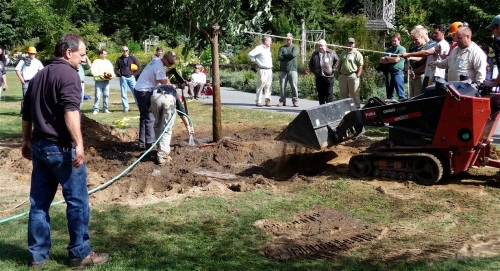
More backfill, more water, and someone still holds the tagline for safety. The Dingo never drives over the root mass, but drops soil onto it from outside the planting hole.
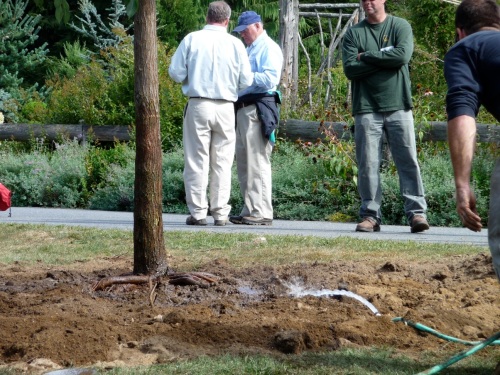
Still more water, as the backfilling continues.

Building the well wall, as water continues to flow.
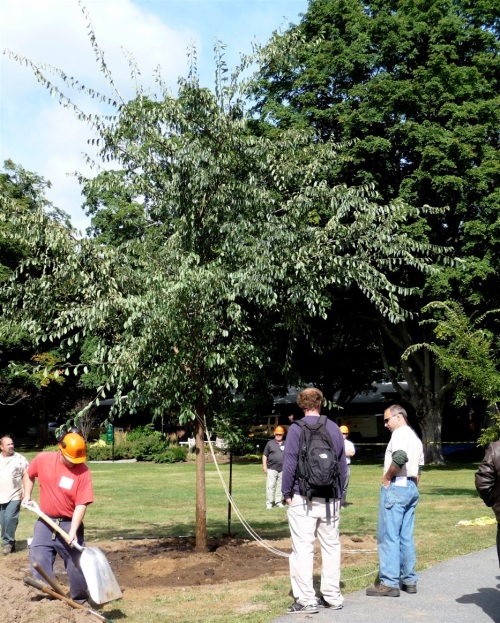
Six-inch caliper elm tree in its new location. Some wilt is evident -- likely because the tree was excavated the day before and the roots had been exposed through the course of the several-hours long workshop. The tagline finally lies slack. Two to four inches of mulch will next be added, and kept away from the trunk.
Demonstrating arborist at this station:
Mike Furgal, Furgal’s Tree and Landscape, Northborough, MA
Air spade tree transplanting
Read Full Post »



